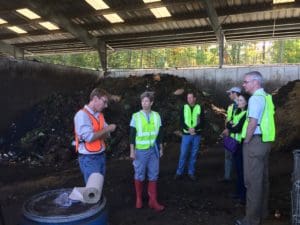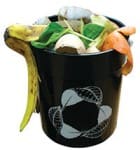 Last October, Urthpact CEO Paul Boudreau sent his leadership team to Green Mountain Compost in Vermont to get the inside view on the challenges that composters face and how to make our compostable plastic products even more eco-friendly.
Last October, Urthpact CEO Paul Boudreau sent his leadership team to Green Mountain Compost in Vermont to get the inside view on the challenges that composters face and how to make our compostable plastic products even more eco-friendly.
Paul Boudreau and the UrthPact team were reminded of a few important facts about composting that they thought would be helpful to pass along. First and foremost is the fact that not all compostable materials breakdown easily. For products to be “certified compostable” they must:
- Break down completely into organic matter
- Break down 90% in 84 days.
- Be consumed by microorganisms in the compost at the same rate as natural materials such as leaves and food scraps
Our vegetable-derived plastics are compostable, but composting must occur in a commercial compost system that utilizes higher temperatures and a greater concentration of bacteria to do the work. They will not break down easily – at least not yet — in a simple backyard compost pile. Fortunately, commercial composting does work well for our retail-use, compostable plastic products.
Just because home composting may not work for everything doesn’t mean you shouldn’t do it, even in cold weather. In fact, once you have your home composting system in place, it’s a simple task to compost year-round. “Wait a minute!” you’re thinking, doesn’t everything slow down – or even stop — in winter? How can microorganisms continue to work in below-freezing temperatures?
It’s all because of something called “oxidation.”
 Oxidation is a chemical process that occurs when microorganisms eat the organic materials in a compost pile, creating energy which, in turn, creates heat. So while it’s true that they may slow down in cold weather, microorganisms don’t stop eating. Believe it or not, the center of your compost pile remains warm and active in winter and early spring. You may see the evidence of steam rising from your compost pile early on a cold morning-all because of the heat generated by composting-loving microorganisms.
Oxidation is a chemical process that occurs when microorganisms eat the organic materials in a compost pile, creating energy which, in turn, creates heat. So while it’s true that they may slow down in cold weather, microorganisms don’t stop eating. Believe it or not, the center of your compost pile remains warm and active in winter and early spring. You may see the evidence of steam rising from your compost pile early on a cold morning-all because of the heat generated by composting-loving microorganisms.
However, a compost pile needs just the right amount of air and water (in addition to carbon and nitrogen) to be successful. So, while water in the summer may be a welcome addition, too much winter water will force air out of pore spaces in your compost pile, suffocating our little bacteria friends. To prevent this from happening, it’s a good idea to build a roof over your compost pile.
It’s also a good idea to create a little more shelter, such as containing it in a box-like structure to help moderate temperature swings and keep more moisture from saturating your pile. Throwing a tarp over your pile is a simple way to do this.
The larger your compost pile, the better it’s able to contain and protect the heat in the center, so make sure you add to it and pile it high during colder weather. Or, go in the opposite direction, dig a hole for your compost, and cover it to minimize heat loss.
No matter how you compost, it’s always a good idea to compost, period. Here at UrthPact, Paul Boudreau and team are always looking for new and better ways to make our environmentally-friendly plastic products even friendlier and compost-ready.



